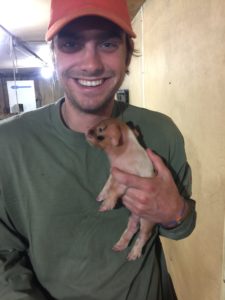We need more farmers like Denny and Brent Friest. This father and son team combines a powerhouse of energy and innovation with a goal of sustainability and smart management practices. Today as a group, we toured the Friest hog barns and learned about the process of raising pigs. The use of gestation crates has become a controversy across the country with them being banned in 5 states including Colorado and Florida. Stories of sick pigs, crushed babies and untreated injuries are often reported in the media, causing panic. I think across the nation, people are asking for humanely treated, grass-fed pigs for a cheap price. Going into this trip, that’s certainly something I wished could be feasible. I wanted to (and still want to) see if we can supply the world with grass-fed, free-range pork.
But this was before I saw the kind of operation Brent Friest is running. His pigs seem relatively happy. They can’t turn around or really move in their confinement, but they’re well fed and watered and their health is monitored. Brent told us that injuries to pigs and piglets increase greatly when they’re allowed to be free range. In the gestation crates, each pigs is ensured food and water whereas in an open feeding crate, the skinny pigs stay skinny and the fatter pigs get fatter. And since these pigs are making Brent money, it doesn’t make sense to have skinny, worthless pigs.
The second biggest problem people have with commercial pig farming is the nurseries which are set up much like the gestation crates with the sow, immobile in the center and the piglets are somewhat separated from the sow, but still have access to the teats and heated mats on the floor. The point of these crates is to reduce the number of crushed piglets and ensure that they have constant access to food. Brent tells us that in pig huts, piglets are more susceptible to cold and being crushed by the sow. To us, the piglets seemed perfectly happy and the sows are fed and watered. And I want to believe Brent when he says that this kind of pig farming is entirely humane and has a greater success rate than free range pig production.
What I want to get at is that this trip was a learning process. A single farmer’s practices can be entirely different from the next farmer and you have to take everything with a grain of salt. It’s up to us to visit all these different farms and talk to companies like Big Pig and figure out where our personal ethics lie. Right now, I don’t really have a problem with how Brent Friest is farming his pigs. His operation is relatively small compared to the bigger companies, and so he’s able to care for each of his pigs individually. That’s something that Brent and his father stressed the importance of. They own and operate their pig farms by their own rules and don’t have to answer to a larger corporation. Later in the trip, we will visit other pig operations and have something to compare the Friests’ practices to. Ultimately, the different pig practices are just an example of what we’re trying to accomplish on this trip—draw from a wealth of sources and create our own opinions when it comes to agriculture and farming in Iowa.

